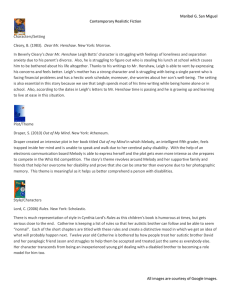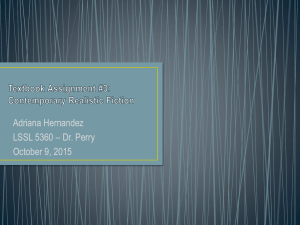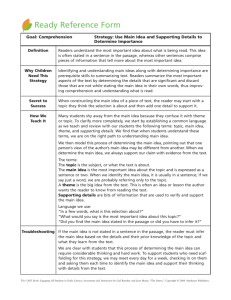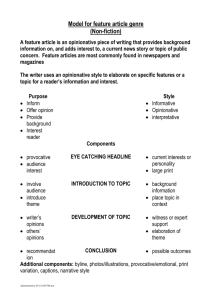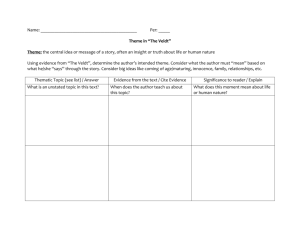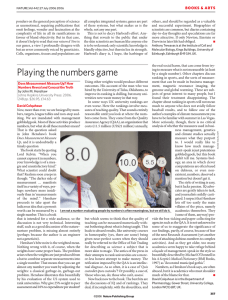TextBook assignment 3
advertisement
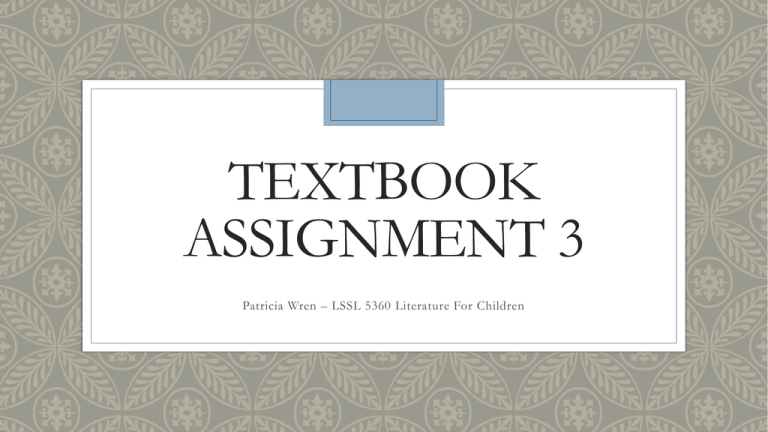
TEXTBOOK ASSIGNMENT 3 Patricia Wren – LSSL 5360 Literature For Children Dear Mr. Henshaw by: Beverly Cleary ◦ Style: To me, this is the most obvious element that this book exemplifies. The story is written in a series of letters from Leigh to Mr. Henshaw. The point of view is important to the story because it is told through Leigh’s perspective and the reader is able to see into his mind as he deals with many issues that young adults face today. ◦ Gender and Culture: From the very first page, the reader is able to see that Leigh is uncomfortable with his name as he signs his name “Leigh Botts (boy)”. This is more obvious throughout the story and Leigh is viewed as a more sensitive boy character as he expresses his thoughts and concerns to Mr. Henshaw. It is also evident in the divorce of Leigh’s parents, his mother is single mom trying to get by and his father is basically nonexistent. ◦ Cleary, B., Zelinsky, P. O., & Juvenile Collection (Library of Congress). (1983). Dear Mr. Henshaw. New York: Morrow. Out of My Mind by: Sharon M. Draper ◦ Characters: I believe this novel exemplifies the evaluative criteria of “characters” because I feel that Melody’s story and emotional journey are far more important than the plot of the story. I especially enjoyed the dialogue that Melody shared with just the readers when she wasn’t able to express herself.. Draper did an excellent job of showing the growth of Melody from the beginning to the end of the story. ◦ Theme: This novel shows a solid theme because like Melody, I feel that many students today also struggle with expressing themselves and being taken seriously and I believe this is something that is meaningful for the reader to experience. ◦ Draper, S. M. (2010). Out of my mind. New York: Atheneum Books for Young Readers. Rules by: Cynthia Lord ◦ Plot: This book is a great example of plot because it is not only fresh and original but it also prepares the reader for the cause and effect of the story. We learn about Kristi and know she is the shallow “popular” girl that Catherine is desperate to befriend, so we can predict that Kristi is going to have a problem with Jason’s disability if they were to go to the dance together. I also believe we get a satisfying resolution when Catherine dances with Ryan because he is her true friend. ◦ Characters: In this book, there are many types of characters that the students could relate to or at least make connections to. Catherine is easily the most identifiable because she is a young adult dealing with trying to fit in while still remaining true to herself, I think this is an issue that all students could connect to. ◦ Lord, C. (2006). Rules. New York: Scholastic Press. A Crooked Kind of Perfect by: Linda Urban ◦ Theme: Urban does a great job of creating a strong theme in this story. Zoe’s family is not the conventional type and it is evident that her father has some type of agoraphobia. Zoe begins to realize that life isn’t always perfect and it is important to keep making music even if it isn’t flawless. I believe the theme of this book is to see the flaws in someone or something and love them or it anyways, which I believe is a meaningful lesson that can be appreciated by any reader. ◦ Style: Urban unfolds this story in unusual way. The chapters are very short and have interesting titles. Even the way some of the text is delivered is presented in an eyecatching way that really shows Urban’s style and even Zoe’s personality. ◦ Urban, L. (2007). A crooked kind of perfect. Orlando: Harcourt. Timmy Failure ◦ Style: This book has a very specific style, and I know it is one that kids today would love, as it reminds me of Diary of a Wimpy Kid, which is hugely popular among elementary students. The way that Pastis presents information by included drawings and side notes, really makes his story stand out from other books. ◦ Characters: The characters in Timmy Failure are very important to the story. Timmy may seem like just a silly kid, but he has lot of heart. Wanting to earn money from his detective business so his mom doesn’t have to worry about bills anymore, says a lot about his character. This is something I think a lot kids today could relate to, especially in this day in age when most adults are very stressed out about bills. ◦ Pastis, S. (2013). Timmy Failure. Somerville, Mass: Candlewick Press. Bridge to Terebithia by: Katherine Parsons ◦ Setting: The setting is a small town. Leslie and Jess are both outcasts who befriend each other. They create their own sanctuary in Terebithia and this setting is detrimental to the plot of the story. They use the imaginary land they created together to provide a safe place for them to be themselves and grow their friendship. ◦ Theme: This book has a very strong theme of friendship. With Leslie’s passing, I think Jess learns that people can have a major impact on your life, no matter how long they are in your lives. When his younger sister is in danger, he saves her and realizes he learned to be courageous from Leslie. ◦ Paterson, K., & Diamond, D. (1977). Bridge to Terabithia. New York, NY: Crowell.
